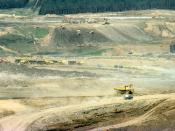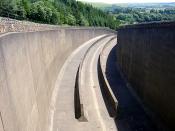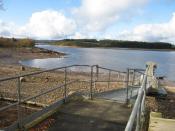The Kielder Reservoir was built in the late 1970's and early 1980's to help to maintain an adequate water supply to the North East. The dam wall was constructed just above the village of Falstone in the North Tyne valley, and the head of the dam lies below the village of Kielder itself, hence its name.
The Kielder project is one of the largest artificially created lakes in Europe, which is situated in one of the largest artificially created forests in Europe - the 101,000 hectare Kielder forest, which is 250,000 acre.
It has a storage capacity of 188,000 million litres which is equivalent to 41,350 million gallons.
One and a half million trees were felled to make way for Kielder Water which has a surface area of 1,084 hectares or 2,684 acres making it larger than Lake Ullswater and three-quarters the area of Lake Windermere.
The Northumbrian Water Authority is responsible for an area of about 930,000 hectares (3,600 square miles), comprising the conurbation of Tyne and Wear, the Counties of Durham and Cleveland, most of the Country of Northumberland, and parts of North Yorkshire and Cumbria.
In the early 1970's the demand for water industries, especially on Teesside, and for domestic purposes was expected to exceed supply by 1981.
A number of reasons were put forward for choosing Kielder:
*The limited agricultural value of the area, and the small numbers of inhabitants living there.
*The natural narrowing of the valley
*The gradient upstream is relatively flat, allowing a maximum volume of water to collect there.
*A band of volcanic rock (Whinsill) would help the foundations.
*The large water catchment area.
*Extensive local deposits of boulder clay, sand and gravel needed in the dam construction.
*It is an area of heavy and reliable rainfall of 1,200 mm a year.


